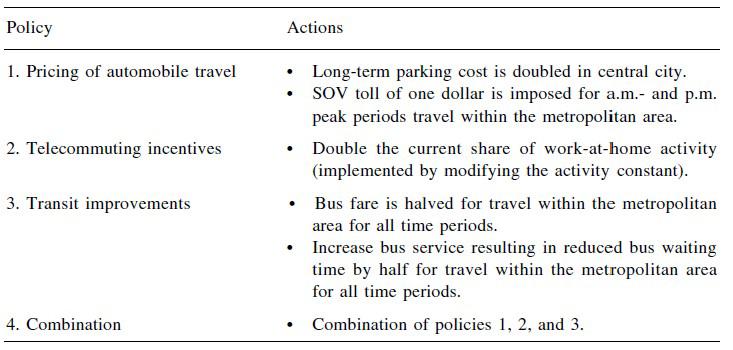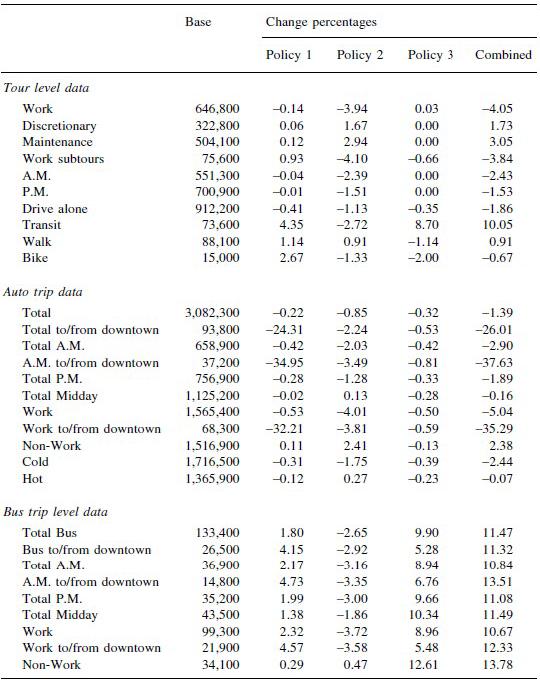
1 minute read
Table 3 Evaluated TDM policies
Source: Shiftan and Suhrbier (2002)
Note. Each policy in table 1 correspond to the policy in table 2. For example, the first policy “Pricing of automobile travel” in table 1 correspond to “Policy 1” in table 2.
Advertisement

Reference
Arlington County Commuter Services. (2018). The Practice of Transportation Demand Management. https://mobilitylab.org/transportation-demand-management/furtherreading/what-is-transportation-demand-management-actually/ California Air Resources Board. (2022). California's Parking Cash-Out Law https://ww2.arb.ca.gov/resources/documents/californias-parking-cash-out-law https://ops.fhwa.dot.gov/plan4ops/trans_demand.htm https://railroads.dot.gov/railroad-safety/divisions/safety-partnerships/railroadinformation-sharing-environment-rise
Creutzig, F., & He, D. (2009). Climate change mitigation and co-benefits of feasible transport demand policies in Beijing. Transportation Research Part D: Transport and Environment, 14(2), 120-131.
Dogterom, N. (2017). Tradable Driving Credits: car users' responses towards an innovative pricing measure in the Netherlands and China Utrecht University].
Fan, Y. (2012). The planners’ war against spatial mismatch: Lessons learned and ways forward. Journal of Planning Literature, 27(2), 153-169.
Farahmand, Z. H., Gkiotsalitis, K., & Geurs, K. T. (2021). Mobility-as-a-Service as a transport demand management tool: A case study among employees in the Netherlands. Case Studies on Transport Policy, 9(4), 1615-1629.
Federal Highway Administration. (2005). Transportation Demand Management.
Federal Railroad Administration. (2023). Railroad Information Sharing Environment (RISE).
Gabriella Abou-Zeid, Michael Grant, Susan Heinrich, & Deep Shah. (2023). An Assessment of the Expected Impacts of City-Level Parking Cash-Out and Commuter Benefits Ordinances. https://ops.fhwa.dot.gov/publications/fhwahop23023/fhwahop23023.pdf
Giuliano, G. (1992). Transportation demand management: promise or panacea? Journal of the American Planning Association, 58(3), 327-335.
Habibian, M., & Kermanshah, M. (2011). Exploring the role of transportation demand management policies’ interactions. Scientia Iranica, 18(5), 1037-1044.
Jamal, S., & Newbold, K. B. (2020). Factors associated with travel behavior of millennials and older adults: A scoping review. Sustainability, 12(19), 8236.
Khaloei, M., & Habibian, M. (2016). Assessing the impacts of transportation demand management policies on mode choice behavior of car commuters with simple work tours. World Conference on Transport Research, Shanghai, Kim, Y., & Kang, S.-C. (2011). Innovative traffic demand management strategy: expressway reservation system. Transportation research record, 2245(1), 27-35.
Lessan, J., & Fu, L. (2022). Credit-and permit-based travel demand management state-of-theart methodological advances. Transportmetrica A: Transport Science, 18(1), 5-28.
Lessan, J., Fu, L., & Bachmann, C. (2020). Towards user-centric, market-driven mobility management of road traffic using permit-based schemes. Transportation Research Part E: Logistics and Transportation Review, 141, 102023.
Litman, T. (2003). The Online TDM Encyclopedia: mobility management information gateway. Transport Policy, 10(3), 245-249.
May, A. D., Kelly, C., & Shepherd, S. (2006). The principles of integration in urban transport strategies. Transport Policy, 13(4), 319-327.
Mayeres, I., Proost, S., Emberger, G., Grant-Muller, S., Kelly, C., & May, A. (2003). Synergies and conflicts of transport packages, SPECTRUM (study of policies regarding economic instruments complementing transport regulation and the understanding of physical measures). Deliverable D4, Institute for Transport Studies, Leeds, UK.


